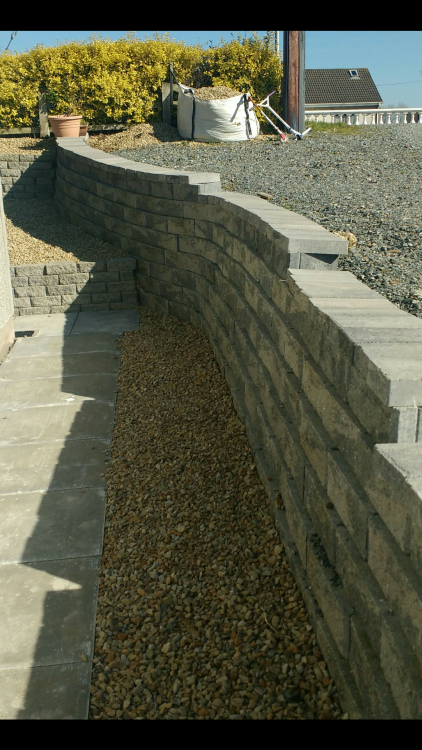Leaderboard
Popular Content
Showing content with the highest reputation on 01/11/18 in all areas
-
Today was d-day for us as far as planning permission is concerned as it was the decision deadline. Approved, no amendments, exactly how it was submitted. I had hoped for the best and prepared for the worst and got the former. Now the real work begins!6 points
-
Hi, I'm at Junction 33. Roughly where are you? If you're passing J33, drop in. We are two minutes away. (PM me) So, you've found the Slog-It Club. Most of us here are in the same boat..... Head down, tails up get on with it, no matter how we feel about it. For this build, today is one of the better days. Our Polish builder has arrived in site, and injected a healthy dose of energy for which I'm very grateful.2 points
-
To say I'm thrilled is an understatement. Our architect gave me a call this afternoon to say that planning permission has been granted and with no changes to what we submitted. I was fully prepared for the worst and even had a plan B in place so that we could deal with the summer bat roost in the roof of the existing bungalow before it becomes active again at the end of spring, so I can set aside that bit of scheming now. I had some concern that the planning officer would object to the larger size of the new building or its increased height but my concerns were unnecessary. One of the main parts of our briefing to the architect was that we didn't want more rooms than we have in our current house (3 bed with a loft conversion), but we wanted larger rooms. Much larger. In this case, size really does matter. Anyhow, all's well for the time being so we best our game face on and start the hard work part of it.1 point
-
All you need to know in one document. Return of fee; page 4 The only thing you will need to check is that the document hasn't been superseded. Ian1 point
-
Never ending story? For a minute there I thought someone had changed the title of my bathroom refurb! Welcome aboard. We like pictures btw!1 point
-
Yes, there should be a backnut and seal with that, as it looks very like the one I fitted a while ago.1 point
-
Not a bad idea, as not only do I know the original registration, but I still have the new plates with it on in the garage!1 point
-
1 point
-
Do those tiles not need to be randomised a little more? Or is that the planned effect eg dark ones along the near edge? Quality looks excellent.1 point
-
+1 HI @oldkettle We have chatted quite extensively before, so I have little more to add, except: - Can you get comparative data for nearby houses on roof height relative to your proposal (thinking of some sort of skyline cross-section sketch showing that in fact yours is not much higher than theirs). If you need to you can rule of thumb their height by counting rows of bricks and roof angles, or visually. IT is interesting that the statement is 'as not been demonstrated' .. it is a lack of information not a rejection. - Probably important to emphasise variety in the street and locality. It is about showing that you fit in, and have a coherent scheme, not that your design is less horrible than some of the others. 6 eyesores already there will not justify a 7th, unless it is demonstrated that it fits in with the locality. ARgue the positive in relation to specific policy. - Ditto floor areas. There are measured floor areas in the EPCs (though some on BH are skeptical). THat may give you additional data that minimises the size differences. - What does the Planner actually want. Do they mean 1.5m, or would 0.8m be acceptable .. it could turn partly on where you think you could win an appeal. CAn you move some way towards that by changing your roofline a little and losing 200mm of ceiling height, or floor buildup depth, for example. I think I would have a conversation, and confirm after by email to document, about what their objections are .. just allow them to talk. THen have another one about possible ideas a few days later. - Or can you play with levels by sinking the whole thing 300mm into the ground on your sloping site? Can't remember how far down you are digging. - 'Incongruous' is a marvellously subjective planning word. Perhaps email the planner to explore how it can be made "congruous" or "harmonious" with the street scene'. IT may also be about finishes as well as scale. COuld you tile-hang the top half, or even use bricks or a blending-in paint or cladding? Cues would need to be local or vernacular. or could you articulate / break up the frontage visually a bit more, and split it vertically or band it by material. ONe idea would be brick on the RHS and render on the left, to reflect the materials of the two neighbour's, or have a column if windows or cladding up the middle. I suspect he thinks it feels big and white and stark. - When it comes to communication, you may be better communicating by ghost writing letters for your architect to send. - It may be worth asking a Local Councillor to take an interest with the planning officer. Again you need to give them enough source material to cut and paste and edit to make it easy for them. - Finally I am sure there are policies about encouraging family life. TIe that into a Planning Statement if you do one, Adequate bedrooms for my children to grow up in in the area where they have friends and schools etc. F1 point
-
@Nickfromwales, water jetting tiles... Seem to remember you occasionally have tiles cut like this. I have had metal cut like this for work and home and seen them cutting "stone" though not paid much attention tbh! How do you supply the tiles to be cut to the water jetter? Maybe marked with a Sharpie that a magic eye cuts to? And do they clamp the tiles to hold them still? @jamiehamy just thinking this outfit might be handy for you sometime: http://www.jetcutit.com1 point
-
Never done it with little tiles Jamie but a bench grinder is cheap and great for accurate lines. Depends how beautiful you want it to be? Job looking great so far?1 point
-
Yes the * is multiply Sometimes a . is used, as is an x, and sometimes there is nothing. U-Value is a measure of power, with the unit W. W means watts and is what is called a derived unit. It is derived from the basic SI units of mass, distance and time. This may sound a bit odd when you think of electricity or solar power, but it really does all make sense. The other derived unit is the joule, J, and is the unit for energy. The old name for energy was heat, and is descried as the ability to do work, the rate at which work is done is called power, which is watt, W. So you can see that there is a relationship between energy and power, with the only difference being time, which is measured in seconds, s. We sometimes use hours (h), 1 hour is 3600 seconds. You may also often see 8760h which is 1 year. So U-Value is W.m-2.K-1 All that means is power divided by metres squared multiples by temperature difference. It may also be written as W / (m2 . K). So if you have a wall, or window, or anything that allows energy to pass though it because of a temperature difference between one side and another, you need to know 3 things initially. The U-Value of the element you are looking to calculate, say a wall with a U-Value of 0.15 W.m-2.K-1 (°C and K are interchangeable) , the surface area on the cold side, say 7.5 m2 and the temperature difference between the two, say 12°C. Multiply them all together (called the product) gives you the power loss in W (watts) 0.15 [W.m-2.K-1] x 7.5 [ m2] x 12 [°C] = 13.5 W Now say you have those exact conditions for 8 hours, you can work out the energy loss in watt hours. This is useful as we buy our energy in kWh, or 1000 Wh. So 13.5 [W] x 8 [h] = 108 Wh, which is 0.108 kWh. If you pay 3p per kWh for gas, then the losses will cost you: 0.108 [kWh] x 0.03 [£] = £0.00324 (or about 0.33p). Now what you have to actually do is work out all your areas and the associated U-Values, get some local weather data, and work out the losses for a whole year. This may sound daunting, but it is what spreadsheets are made for. Hope that helps and feel free to ask about any bit you do not understand (and I may have made an error anyway). Here is a power loss calculator I knocked up a while back. https://steamytea.wixsite.com/u-valuecalculator1 point
-
i wouldn't use a shallow bath for cutting the tiles unless it was a petrol cutter - just do it dry and make sure the wind is going the right way. put some tape over where you are going to cut to help stop cracking never done hexagonal tiles so don't have any special advice for them!1 point
-
I used one of the dry stone systems to hold back my driveway. It doesn't need a concrete base but you can put one in if you want. It's very simple to build, the blocks have a lip at the back edge so you can really go wrong. My wall at its highest is 1.6m so I had to use the larger blocks. The other smaller walls in the pic are made with a much smaller block but you can't go higher than 1.2m so as Jeremy suggests I used two walls with decorative some in between to get me the height I needed. There is near 30m of wall and it cost approx £2000 over 3 years ago. This is where I got it from. https://professional.ag.uk.com/products/retaining-walls/anchor-diamond It goes to a max height of 3m with the use of a geo grid.1 point
-
Do you need a big retaining wall, or can you terrace that bank instead? Terracing, with walls not exceeding 1.2m, significantly reduces the work needed, and below 1.2m a retaining wall can be a standard design, reducing costs still further.1 point
-
1 point
-
0 points


.jpg.c21f3ac78c9b7efd90cbdcb312744dc5.thumb.jpg.7adcad4c0e384f5ecd7d56b0618df6e5.jpg)





